The First Residents of Edenton, North Carolina
2000 Years Ago and Beyond!
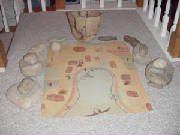
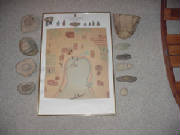
In 1973 at the age of 15 years, I made my first encounter with a Professional Archaeologist by the name of Dr. David Phelps from East Carolina University. He clued me in regarding the FIRST RESIDENTS of Edenton, North Carolina and authorized the work I hoped to accomplish. Dr. Phelps, during his retirement, had significant success investigating sites where the well known "Lost Colony" may have landed.
As part of my Eagle Scout Project in Troop #164, I wanted to discover and excavate the property of these earliest inhabitants in Chowan County. I already knew the word, "Chowan," was derived from the Algonquian speaking Native Americans who met the first Europeans. Next, I needed to find out where they lived.
I was fortunate to discover the remains of an intact village. It was fast becoming a wasteland. I knew that in no time at all, it would be completely obliterated and destroyed. It was part of a sand removal project for the construction and development of highways and other residential properties in the area. It would not be long before the early evidence of these First Residents would be erased for all of eternity.
Dr. Phelps and the proper authorities at the State level assisted me in labeling a string of these villages as sites 31CO2/31CO3/31CO4 and 31CO5. With the assistance of a local artist, Miss Jackie Parker, I was able to recreate the village you see below--(utilizing the early drawings of John White--Colony artist and one time governor of the first English colony in America--best remembered as "The Lost Colony").
The clay tempered pottery vessel (marked with the woven fabric of these people) shown at the top of that portrait was identified by Dr. Phelps as one of the earliest clay pottery vessels he had ever seen. It came from the Early Woodland Period--dating approximately 2000 to 3000 years old (site 31C04).
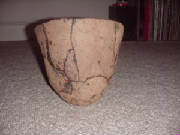
Here is a close up view. Notice the black marks left from the fire pit on the surface of the pot. These clay pots were made by laying the clay coils on top of each other and smoothing the coils out with a wooden paddle--usually covered with woven fabric, cord or knotted fish netting. The pots were pointed on the bottom so that the pots could sit down into the coals of the fire. If they had been flat bottomed, they would have extinguished the fire.
One can break down the earliest human populations in this area into three periods--the Paleo Period dating 14,000 to 10,000 years ago--the Archaic Period dating between 10,000 and 3000 years ago; and finally, the last 3000 years as the Woodland Period. These dates may vary from expert to expert. From time to time they change with the production of new books or new ideas--but as they are outlined here, they are a good representation for understanding the development of the native american population in this area.
The Paleo Period saw people making Spear Points in a "Fluting" fashion. They are often known as Clovis or Folsom Points. The "black flint point" is the bottom half of a Clovis Point found not too many miles from this Early Woodland Village. It had been used by people living in the area between 8000 years and 12,000 years before this Early Woodland Village showed up along the Chowan River. The gray point is very interesting in that it is neither Clovis or Folsom but is definitely "fluted" along the center of the bottom shaft of the point. The small white quartz LeCroy Point shown here also comes from this earliest period and is NOT an arrowhead. The bow and arrow was not invented until the Early Woodland Period.
For those wondering about how these resourceful people built their houses during the Woodland Period--remember, during the Paleo and Archaic Period, they stayed mobile, so, "mobile homes" were the product of that day. During the Woodland Period, however--Very simply, they bent pliable trees over and created a frame and covered the frame with woven mats. So, just like us, they preferred and utilized that age old concept of the "Frame Built House."
OK, back to the Archaic Period--During the Archaic Period, area residents used a Spear Thrower known as the Atl-Atl to throw the Spear (or as archaeologists like to say the "Projectiles"). Some of the commonly named Projectiles from this period are Savannah River, Morrow Mountain, Stanley, Halifax, Guilford, Kirk and Palmer. Keep in mind, people then are like people now. Just like we have styles of cars and clothes that can date our time in history, the styles of these points can help pinpoint time in this region's Pre-history.
In the photo below there are paleo period fluted points to the left side. The two points pictured beside the Paleo Points fit the Stanley and Morrow Mountain Point style tradition, and those two points were found near Roanoke Rapids, NC around 1920 by an Edenton Historian, Elizabeth Van Moore. They come from the Archaic Period 3000 to 10,000 years ago. Next to those two points is an early Knife, and above it is an Archaic Point that appears to have been reshaped. This point was found in the Early Woodland Village near the Pottery Vessel. Since it shows evidence of being re-shaped, a good detective might surmise that it was an Archaic artifact rediscovered by a Woodland Villager and put back to work. Imagine, if you were walking through the woods and found an old 1930 abandoned Packard Car with the keys and gas in it--wouldn't you put it back in action?
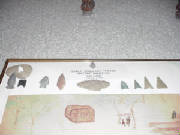
The four projectile points to the right of the photo are Woodland Period arrowheads. To the left of those points is what appears to be an archaic period Morrow Mountain style projectile point that has been reshaped into a knife. During the woodland period, the arrowheads were usually some kind of triangular shaped point. In early woodland, the base of the old archaic style points started to disappear. At first, the arrowheads tended to have a little bit of a base. Archaeologists typically called the early woodland period points--"earred triangular." Soon the entire base was gone and the points were triangular with flat bottoms, but usually triangular with the inverted bottoms exposing barbed points on the left and right side.
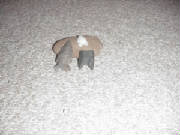
Pictured here is the bottom half of a clovis point (black flint)--13,000+years old, another grey flint point resembling a Hardaway style projectile--10,000+ years old and a white quart Lecroy style point--also 10,000+ years old. Also three points were found in Perquimans County, next door to Edenton and were made using a fluting method. Fluted points are characteristic of the Paleo-period native americans and resemble the method used to make projectile points in southern France as long ago as 30,000 years.
Here is what happened. During the Paleo Period, the really big animals like Mastodon were pursued. After the Ice Age, ICE began to melt away; and the Hunters sought smaller game like deer and elk. One day, someone noticed a seed he or she (Yeh! She probably noticed before he did.) dropped on the ground and realized it had sprouted and produced food later in the season. Consequently, the local residents began to add food production to their hunting and gathering skills. Soon, they discovered they needed POTS to store and keep the food. So, someone had to invent pottery making. That's when my POT was made. Also, since time was being taken up with all of this food production, someone needed to figure out a quicker and more efficient way to take down game animals. One thing led to another and the technology of the "bow and arrow" arrived on the scene. This new technology supported the creation of more free time--and together, agricultural and technological advances made it possible for pursuing other activities--including art, religion, pottery making and trade.
Mortar and Pestle tools (Also referred to as Mortis and Pestle--Corn Grinder--Grinding tool) like these shown below were popular in the late archaic period and were useful tools for roots, nuts, and whatever else needed grinding. They were a carryover into the agricultural period of the Woodland tradition. Nice large wooden mortar and pestles used mostly during the middle to late woodland period have long disappeared. Notice the one with the slit in it (third one from left to right--found near Scotch Hall Preserve in Bertie County)--this was a shaft straightenerworking much like a sander to straighten wooden shafts for projectile points and knives. The first one came from Pembroke Creek near Edenton's water treatment plant. The second came from near Cannon's Ferry in Edenton. And the last one came from a site near Suffolk, Virginia.
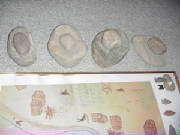
In addition to these types of stone tools, hand held axes and axes attached to wooden shafts were also popular in this region. People ask me how the rock came to this area. While some trade took place, it is now generally accepted that one or more of the recent ice ages washed down significant rock bolders into the rivers and sounds here in eastern North Carolina. Much of that rock was quartz, and a majority of your projectile points are quartz--ranging in colors from orange to red, to white and to gray. Sometimes, you discover a strange rock that is not characteristic. The black stone axe tool shown below is one such rock. It appears to have etchings on the surface, and it reminds me of the moon rocks I have seen at Langley Air Force Base in Virginia. The broker axe was an interesting find. In 1974, I discovered the larger section at today's Edenton Water Treatment plant near Pembroke Creek, and in 1975, I found the other section and remembered what I had found the year before. Believe me, you remember those things. And there it was--a perfect fit. The large brown celt tool was found near Edenton Bay. The greenish hand celt tool (perfectly sharp--I don't think the individual who sharpened it must have had any chance to use it!)--this tool was found near this pottery vessel, but several feet above the level of this pot.
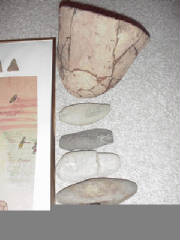
So, about 2000 to 3000 years ago, the local residents began to shift their drive toward "civilization" into high gear and things really began to take off. By 1000 A.D., most features of civilization as we understand it were basically in place. They included multiple villages controlled by a central governing authority--religious leaders advising folks about how to think and believe--organized festivals and sporting events--a complex system of barter and trade. War for the advancement of one's cultural interests was also very important. Some experts say if the Europeans had been 100 years later in their arrival, many of the Eastern Tribes may have already reached that last requirement for scientific classification as a civilization--"a written language"--making it efficient and easy to communicate all of the great advances of the newborn civilized culture that defines us as modern human beings. Of course some philosophers may see these advances more as growing pains. But the idea is that somewhere near the end of the tunnel, civilized man reaches that zenith of a utopian society--if he doesn't destroy himself first.
Enough with the philosophy--NOW, back to the POT--In the winter of 1973 when I walked down the bull dozer ramp and picked up that little piece of pottery and began to walk away, figuring it was just one more small pottery shard like the hundreds I had found in the past, something told me to turn around and go back and dig down a little bit. Sure enough, those 98% of the pieces of that pot were just missed by the bull dozer blade; and luckily, I decided to take a second look; and as they say, "the rest is History."
Oh yes, after discovering the POT, I realized the site was still intact and I recovered several other pots that were between 30% and 70% complete. Here they are below: marked with two styles of cord wrapped wooden paddles and the middle pot with knotted fish net. The first pot to the left was actually recovered from a test pit when I discovered an abandoned site in 1975 near Pembroke Creek at the present day Edenton Treatment Water Plant. At the time, it was supposed to be labeled site #31CO5, but that number may have been assigned about half of mile away where the very unusual Black Axe tool (moon rock!?) had been found.
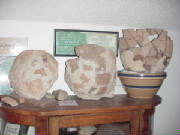
Below is a fabric marked vessel found with punctated indentions in the top of the rim. This was at the same site as the original pottery vessel. While it shows a different style of fabric marking and also very heavy sand tempering rather than clay tempering, it is safe to say that this site was occupied and reoccupied heavily for many centuries. The greenish gray hand tool was also found at this location. Keep in mind this site was eventually completely destroyed by bulldozing, and these salvaged memories are all that remain.
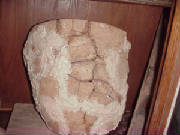
For thirty years, I have shared this with hundreds of thousands of people through traveling exhibits and educational presentations. Now, I want to share it via the Internet and especially with my Real Estate clients. Hopefully, it will have the same meaning for you that it has for me. We are not the first and let's not fool ourselves--We will not be the last. Enjoy the photos and email me and let me know how you like the resources and articles on my website.
Thank you for taking time to tour this exhibit and for being part of my past. Take care.
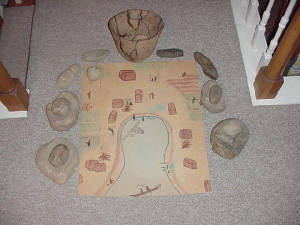
SHOWN ABOVE: AN ARTISTS WATERCOLOR RENDITION OF A 2000 YEAR OLD VILLAGE NEAR EDENTON WITH ARTIFACTS DAVID McCALL DISCOVERED OVER THIRTY YEARS AGO! LEARN ABOUT THESE FIRST RESIDENTS OF EDENTON, NORTH CAROLINA.
Footnote: One interesting thought about recent discoveries regarding North America's earliest inhabitants----Many now believe Europeans were in North America 17000 years ago. This new revelation has taken place since the discovery of European artifacts along the eastern Seaboard of North America that date 17,000 years old.
It has been reported that genetic testing indicates 25% of Native Americans are genetically linked to Europeans. Just like the land bridge crossed by nomads from Asia to the artic Northwest, Europeans crossed the land bridge created by ice in the Northeast about 17,000 years ago. Later, they blended with the populations migrating out of the Northwest.
One theory suggests around 13,000 years ago, a large meteor may have hit a large ice glacier in the northern regions of North America. Times became very difficult, and the populations from the northeast and from the northwest were forced into the deep southern reaches of the North American continent. Geological studies definitely show a 1000 year era during that time where peoples living in the Americas dwindled greatly in population--but in the end, they emerged as vibrant and strong survivors of a tough environmental change. This is exciting new information in the world of achaeological discoveries and opens a lot of doors for discovering more about the First Residents of Edenton, North Carolina and beyond!
LOST TREASURE BY David E. McCall
I have always had the fever for treasure hunts and great discoveries. In fact, when I was told in 1969 at age 11 that Native Americans (referred to at that time as Indians) lived right outside my backdoor in Edenton, North Carolina, I immediately began to search for the evidence.
Four years later, with the discovery of four ancient villages and a complete two-thousand year old pottery vessel, I became a believer; and it set the course for my future.
In my twenties, I became the Program Director of North Carolina's oldest brick house, The Newbold-White House (Ca. 1730) in nearby Hertford, North Carolina--home of baseball legend Jimmy "Catfish" Hunter and the roots of current Red Sox star, Trot Nixon.
Great discoveries continued with that line of work. Archaeological treasure in nearby fields and research into Colonial living brought back to life those early years in eastern North Carolina--in fact, an understanding of the birth of early American life in a region that was known as "The Cradle of the Colony."
In my thirties, I took a right turn and utilized my investigative spirit by serving ten years as a Child Abuse Investigator and writing a book called, "Crimes Against Children."
Now, in my forties, I have come full circle, built my home on one of the ancient village sites and found myself in a profession not unlike the Historical Marker on a nearby highway.
On that marker, it names my eighth great-grandfather, George Durant, as one of the earliest settlers to buy land from the Native Americans in this region in the 1600's. Soon after that, thousands of Virginians and others from the northeast began to heavily populate this northeastern corner of North Carolina.
And many of the treasures that those earliest settlers found or even brought to the region are the same treasures being discovered again by the same migration that took place 300 years ago.
It really is true. History does "repeat itself." Northeastern North Carolina land (especially waterfront) has suddenly started to appreciate at astronomical rates. The increase in population movements from a little north in Virginia has started to accelerate. And the tax burdened North is realizing $100K in the North is like $1M in eastern North Carolina.
And what about my newest profession--well, I've joined the ranks of Real Estate Sales and learned that lost treasures are still discoverable. While I thought the cat was out of the bag and prices were already driven up, I recently engaged in negotiations on a piece of property with many hidden treasures. Appraisers, bankers and even other real estate agents missed several of the hidden assets to the property.
This was an 1830 farmhouse located on six acres of cleared farmland backed up to a row of 2000-2500 sq. ft. brick homes along the Perquimans River in an area near Durant's Neck--that's right, the original piece of land Grandpa bought from the Native Americans.
While all of these parties felt the value of the property was just barely fair, I had to
contain myself over the real value of this lost treasure.
Yes, the home needed lots of renovation. But inside the home was a treasure house of Federal Period mantles with sunburst design, wainscoting, hand-wrought strap, H, and H & L hinges and extra wide heart pine flooring that would make any sawmill manager weep with joy upon seeing.
While some may consider salvaging the house interior, selling it to northern antique
markets for the asking price on the home and still having six pristine acres 100 yards from the waterfront; the prospective owners plan to preserve and protect the hidden treasures within the antebellum structure and find other streams of income from this valuable piece of property.
As the Virginians march south, they like to bring their horses. For short term income, the owner can easily earn enough boarding fees to more than make the payment. Then, the owner can apply to set up a much needed cell phone tower where approximately $250 per provider on the tower can be collected as monthly rental.
In the end, as the waterfronts disappear and the waterviews become diminished,
that six acres will sit there and grow in value way beyond the current asking price.
Lost treasures like this are actually easy to find. Realizing their value is the difficult task.
One additional treasure comes with anyone retired from the military. North Carolina no longer taxes military pay; and many Virginians are finding out that a move to North Carolina creates an immediate pay increase.
A new community is being created near Historic Edenton--which is currently only a
town of 5800 residents. That community, known as Sandy Point, has planned 2000 new units near the water with a complete downtown for its residents.
And by the way, that area needs cell phone coverage. Conveniently, it is a straight shot across several peninsulas from the 1830 farm.
As it develops, such a community will be larger than Edenton has ever been in its
300 year history.
Soon, lost treasures may indeed finally be lost, but it has been fun finding them;
and I will remain confident that the development of the "Cradle of the Colony" will
continue in a positive way throughout eastern North Carolina to the benefit of all
of its residents.





